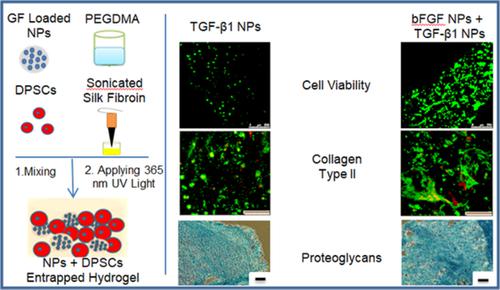当前位置:
X-MOL 学术
›
J. Biomed. Mater. Res. Part B Appl. Biomater.
›
论文详情
Our official English website, www.x-mol.net, welcomes your
feedback! (Note: you will need to create a separate account there.)
Dual growth factor delivery using PLGA nanoparticles in silk fibroin/PEGDMA hydrogels for articular cartilage tissue engineering.
Journal of Biomedical Materials Research Part B: Applied Biomaterials ( IF 3.2 ) Pub Date : 2019-12-24 , DOI: 10.1002/jbm.b.34544 Milad Fathi-Achachelouei 1 , Dilek Keskin 1, 2, 3 , Erhan Bat 1, 4 , Nihal E Vrana 5, 6 , Aysen Tezcaner 1, 2, 3
Journal of Biomedical Materials Research Part B: Applied Biomaterials ( IF 3.2 ) Pub Date : 2019-12-24 , DOI: 10.1002/jbm.b.34544 Milad Fathi-Achachelouei 1 , Dilek Keskin 1, 2, 3 , Erhan Bat 1, 4 , Nihal E Vrana 5, 6 , Aysen Tezcaner 1, 2, 3
Affiliation

|
Degeneration of articular cartilage due to damages, diseases, or age‐related factors can significantly decrease the mobility of the patients. Various tissue engineering approaches which take advantage of stem cells and growth factors in a three‐dimensional constructs have been used for reconstructing articular tissue. Proliferative impact of basic fibroblast growth factor (bFGF) and chondrogenic differentiation effect of transforming growth factor‐beta 1 (TGF‐β1) over mesenchymal stem cells have previously been verified. In this study, silk fibroin (SF) and of poly(ethylene glycol) dimethacrylate (PEGDMA) were used to provide a versatile platform for preparing hydrogels with tunable mechanical, swelling and degradation properties through physical and chemical crosslinking as a microenvironment for chondrogenic differentiation in the presence of bFGF and TGF‐β1 releasing nanoparticles (NPs) for the first time. Scaffolds with compressive moduli ranging from 95.70 ± 17.82 to 338.05 ± 38.24 kPa were obtained by changing both concentration PEGDMA and volume ratio of PEGDMA with 8% SF. Highest cell viability was observed in PEGDMA 10%‐SF 8% (1:1) [PEG10‐SF8(1:1)] hydrogel group. Release of bFGF and TGF‐β1 within PEG10‐SF8(1:1) hydrogels resulted in higher DNA and glycosaminoglycans amounts indicating synergistic effect of dual release over proliferation and chondrogenic differentiation of dental pulp stem cells in hydrogels, respectively. Our results suggested that simultaneous delivery of bFGF and TGF‐β1 through utilization of PLGA NPs within PEG10‐SF8(1:1) hydrogel provided a novel and versatile means for articular cartilage regeneration as they allow for dosage‐ and site‐specific multiple growth factor delivery.
中文翻译:

在用于关节软骨组织工程的丝素蛋白/PEGDMA 水凝胶中使用 PLGA 纳米颗粒的双生长因子递送。
由于损伤、疾病或年龄相关因素引起的关节软骨退化可显着降低患者的活动能力。在三维结构中利用干细胞和生长因子的各种组织工程方法已被用于重建关节组织。先前已证实碱性成纤维细胞生长因子 (bFGF) 的增殖影响和转化生长因子-β1 (TGF-β1) 对间充质干细胞的软骨分化作用。在这项研究中,丝素蛋白(SF)和聚(乙二醇)二甲基丙烯酸酯(PEGDMA)被用来为制备具有可调机械、在 bFGF 和 TGF-β1 释放纳米粒子 (NPs) 存在下,通过物理和化学交联作为软骨分化微环境的溶胀和降解特性。通过改变 PEGDMA 的浓度和 PEGDMA 的体积比与 8% SF,获得了压缩模量范围为 95.70 ± 17.82 至 338.05 ± 38.24 kPa 的支架。在 PEGDMA 10%-SF 8% (1:1) [PEG10-SF8(1:1)] 水凝胶组中观察到最高的细胞活力。bFGF 和 TGF-β1 在 PEG10-SF8(1:1) 水凝胶中的释放导致更高的 DNA 和糖胺聚糖量,表明双重释放对水凝胶中牙髓干细胞的增殖和软骨分化的协同作用,分别。
更新日期:2019-12-24
中文翻译:

在用于关节软骨组织工程的丝素蛋白/PEGDMA 水凝胶中使用 PLGA 纳米颗粒的双生长因子递送。
由于损伤、疾病或年龄相关因素引起的关节软骨退化可显着降低患者的活动能力。在三维结构中利用干细胞和生长因子的各种组织工程方法已被用于重建关节组织。先前已证实碱性成纤维细胞生长因子 (bFGF) 的增殖影响和转化生长因子-β1 (TGF-β1) 对间充质干细胞的软骨分化作用。在这项研究中,丝素蛋白(SF)和聚(乙二醇)二甲基丙烯酸酯(PEGDMA)被用来为制备具有可调机械、在 bFGF 和 TGF-β1 释放纳米粒子 (NPs) 存在下,通过物理和化学交联作为软骨分化微环境的溶胀和降解特性。通过改变 PEGDMA 的浓度和 PEGDMA 的体积比与 8% SF,获得了压缩模量范围为 95.70 ± 17.82 至 338.05 ± 38.24 kPa 的支架。在 PEGDMA 10%-SF 8% (1:1) [PEG10-SF8(1:1)] 水凝胶组中观察到最高的细胞活力。bFGF 和 TGF-β1 在 PEG10-SF8(1:1) 水凝胶中的释放导致更高的 DNA 和糖胺聚糖量,表明双重释放对水凝胶中牙髓干细胞的增殖和软骨分化的协同作用,分别。











































 京公网安备 11010802027423号
京公网安备 11010802027423号